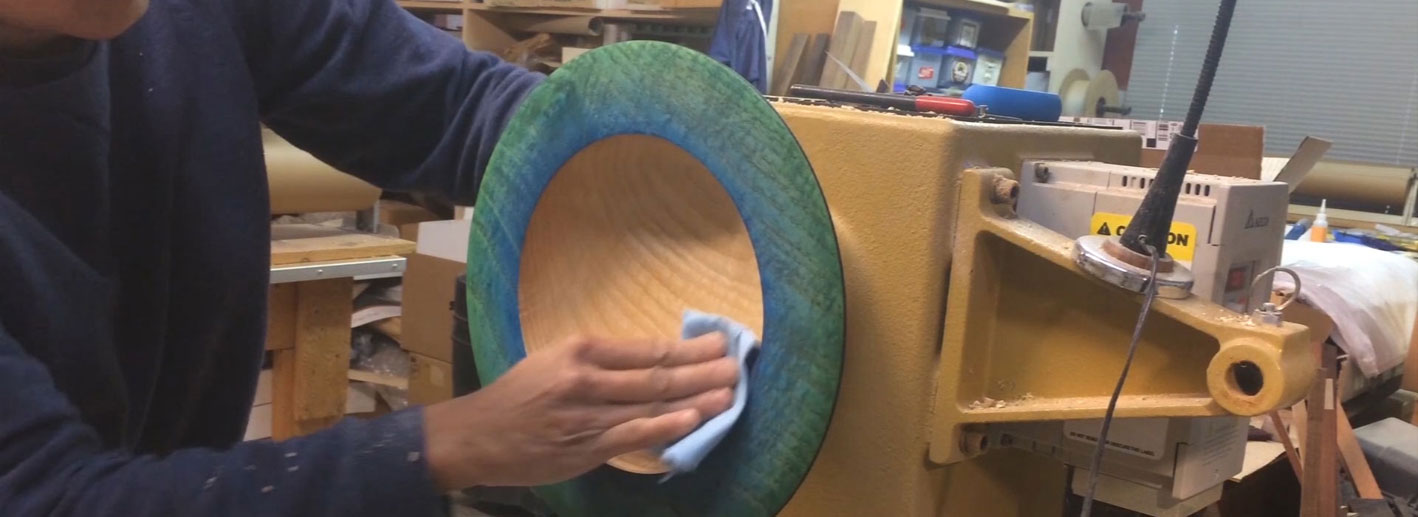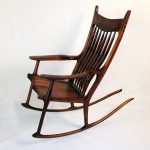

Name of Project: Maloof Inspired Rocking Chair.
Material: Black walnut, ebony plugs, wenge detail on the rockers.
Finish: Basecoat of Tried and True Danish Oil, 3 coats of Maloof-finish (linseed Oil, Tung Oil, polyurethane), 3 coats of Maloof-wax (Tung Oil, linseed oil, wax). Application was done with progressively finer grits of sandpaper.
Project Notes:
Several years ago, I contemplated the possibility of making a Maloof-style rocking chair. Sam Maloof (1916 – 2009) was one of America’s iconic furniture designers of the mid to late 20th century. His work is timeless and it is even in exhibition at the Smithsonian. I really loved his designs, they are visually elegant, simple, striking, and at the same time very functional and inviting. His rocking chair invites you to seat on it, it is extremely comfortable, and the finish is smooth and relaxing.
I wanted to make a Maloof chair as an exercise and to further my education, edify and improve my woodworking technique. This was an intimidating project at the time, so I worked on others instead.
More time has passed, and I finally felt qualified to tackle the project. The chairs employ almost everything I know about woodworking and even more. Techniques involved are compound angles, routing, wood turning on a lathe, band saw shaping, grinding, sanding and sculpting skills, bent lamination, finishing. Making these chairs has been like taking a graduate class on woodworking.
There are many plans, drawings and instruction on making these chairs online. A few craftsmen that teach and provide plans are Charles Brock, Marc Spagnuolo (who made a Brock chair), Scott Morrison, etc. The base plans I used were those of Scott Morrison, who I think approaches the project in a manner closer to what Maloof intended. Additional sources were all the Sam Maloof books and videos I could find, particularly his auto-biography: Sam Maloof, Woodworker.
This chair is made mostly with solid 8/4 walnut. There is a lot of work in this chair due to its sculptural quality. It took me over 160 hours to make it. Out of this time 35 hours were dedicated to grinding and sanding the wood to its fine shape; 12 hours were spent on the spindles; 7 hours on the shaping of the headrest and 7 hours were spent in the finishing process in a period that took one week to complete. The trickier part was to know when to stop shaping and grinding, as one can take wood away, but it cannot be replaced if one takes too much.
The smooth rockers were achieved with bent lamination. For these I had to painstakingly cut 1/8” wide strips of wood on a table saw. Ten strips made a rocker. These were glued and shaped by clamping them on a jig with their intended shape, and then routed in the shape of a tube.
The chair was designed for someone of average build between 5 ft. 5 inches to 5 ft. 10 inches. A friend asked me the other day: “Would you sell them?” My answer: “Yes. Everything is for sale. Lol!” Seriously, if you would like a chair like this, I would probably need three months lead time and the price would be in the upper four figures. It is rare to have a fully handcrafted piece these days with all the industrialization and cheap Chinese made goods that surround us. But it is my firm belief that we should not sell ourselves short on beauty, quality and soul.
Name of Project: “Barristerial Menagerie” (Barrister Bookcase)
Dimensions: 34” long x 15” wide x 71” high
Material: Cherry wood / cherry veneered plywood / stained glass door panels
Finish: Danish Oil plus Linseed Oil/Polyurethane mix with a final wax finish
Project Notes:
The main design for this project was inspired by Marc Spagnuolo’s (www.woodwhisperer.com) design. His ideas on the nesting of the boxes were used for this project, along with his solution for the action on the doors. The doors have minimal hardware, as they ride on groves with a pin pivot.
My changes in the design involved adding a fourth “box” or level to the bookcase. Graduating the size of the boxes, I also simplified the carcass design by reducing the complexity of the panels, and added the stained glass decorative detail.
For a full description of this project, please see my blog posts on the subject.
Click here to go to Part 1 of 3, which describes the construction of this piece.

